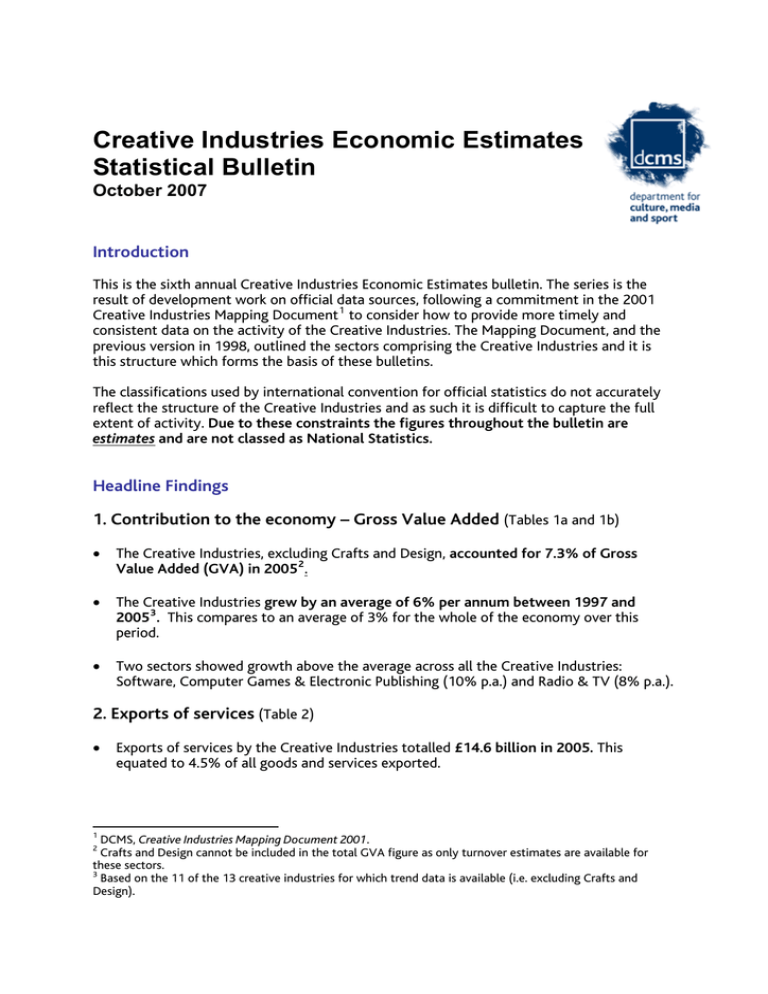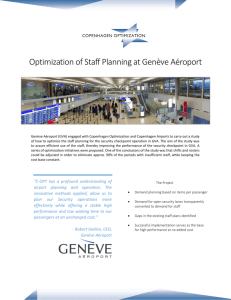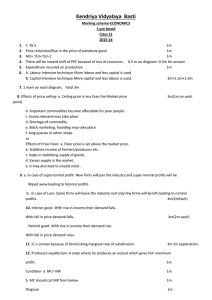Creative Industries Economic Estimates Statistical Bulletin October 2007
advertisement

Creative Industries Economic Estimates Statistical Bulletin October 2007 Introduction This is the sixth annual Creative Industries Economic Estimates bulletin. The series is the result of development work on official data sources, following a commitment in the 2001 Creative Industries Mapping Document 1 to consider how to provide more timely and consistent data on the activity of the Creative Industries. The Mapping Document, and the previous version in 1998, outlined the sectors comprising the Creative Industries and it is this structure which forms the basis of these bulletins. The classifications used by international convention for official statistics do not accurately reflect the structure of the Creative Industries and as such it is difficult to capture the full extent of activity. Due to these constraints the figures throughout the bulletin are estimates and are not classed as National Statistics. Headline Findings 1. Contribution to the economy – Gross Value Added (Tables 1a and 1b) • The Creative Industries, excluding Crafts and Design, accounted for 7.3% of Gross Value Added (GVA) in 2005 2 . • The Creative Industries grew by an average of 6% per annum between 1997 and 2005 3 . This compares to an average of 3% for the whole of the economy over this period. • Two sectors showed growth above the average across all the Creative Industries: Software, Computer Games & Electronic Publishing (10% p.a.) and Radio & TV (8% p.a.). 2. Exports of services (Table 2) • 1 Exports of services by the Creative Industries totalled £14.6 billion in 2005. This equated to 4.5% of all goods and services exported. DCMS, Creative Industries Mapping Document 2001. Crafts and Design cannot be included in the total GVA figure as only turnover estimates are available for these sectors. 3 Based on the 11 of the 13 creative industries for which trend data is available (i.e. excluding Crafts and Design). 2 • A third (33%) of the total Creative Industries exports was contributed by the Software, Computer Games & Electronic Publishing sector. 3. Employment (Table 3) • In the summer quarter of 2006, creative employment totalled 1.9 million jobs. This comprised just over 1.1 million jobs in the Creative Industries and almost 800,000 further creative jobs within businesses outside these industries. • Total creative employment increased from 1.6m in 1997 to 1.9m in 2006, an average growth rate of 2% per annum, compared to 1% for the whole of the economy over this period. • Software, Computer Games & Electronic Publishing showed the largest increase in employment between 1997 and 2006 with an average growth rate of 6% per annum. The Design sector, including Designer Fashion, also showed an increase above the overall average for the Creative Industries over the period (4% per annum). 4. Numbers of businesses (Table 4) • In 2006, there were an estimated 120,700 businesses in the Creative Industries on the Inter-Departmental Business Register (IDBR). This represents 7.3% of all companies on the IDBR, although the true proportion of enterprises that are in the Creative Industries is likely to be higher as certain sectors such as Crafts contain predominantly small businesses - see Annex C for further detail. • Around two-thirds of the businesses in the Creative Industries are contained within two sectors; Software, Computer Games and Electronic Publishing (53,500 companies) and Music and the Visual & Performing Arts (28,300 companies). NOTES Revisions Since the last bulletin (published September 2006) some revisions have been made in methodology and chosen source data, along with some updates to previous years’ data. The data source for Design industry turnover has changed from British Design Innovation’s (BDI) “Design Industry Valuation Survey” to the Design Council’s “The Business of Design”. BDI data is based on a membership survey and concerns were raised that the data may fluctuate according to membership levels rather than industry-wide trends. The Design Council data also reflects a wider definition of the Design industry, including freelance designers and in-house design teams instead of just design consultancies. Rather than create a discontinuity in the data, a new series has been started for Design using data from the Design Council which is planned to be updated every three years. The old BDI data has been removed from the series. However, the estimate of Design exports (Table 2) uses the BDI data as it is still considered to be the best available source. Along with a change in the data source for Design there has been a revision to the method used for calculating the Creative Industries total GVA and contribution to UK GVA. In 2 previous bulletins the estimate of Design industry turnover was added to the GVA contributions of other sectors to produce the total figures. This is because it is not possible to identify Design in national statistical sources which are used to calculate GVA, meaning an estimate of turnover has to be used as a closest proxy. However, turnover and GVA are not directly comparable measures as turnover will always be larger than GVA 4 . Previous estimates of total Creative Industries GVA acknowledged this fact and may have resulted in a slight overestimation. Alongside the change in source for the estimate of Design industry turnover, the decision has been taken to exclude the sector from the estimate of total Creative Industries GVA (as had previously been the case for the Crafts sector). Instead the turnover figure is presented separately at the end of the GVA table. See Annex B for further details of the revisions, including the impact on the backdated series. Interpretation of the figures All readers should be aware that: 1. All figures are estimates since they draw on fixed assumptions of the correspondence between the definitions of the Creative Industries and the definitions used in official sources. These are shown in Annex A. 2. As far as possible National Statistics (NS) sources are used as the basis for the estimates to ensure consistency and hence comparability between sectors. Where NS data are not available other research has been used which may not have been subjected to the same quality checks. It therefore follows that these estimates, and some of the overall totals which may include these estimates, may not be as reliable as National Statistics. 3. With the exception of the number of businesses counts, sources are sample surveys. These data are thus subject to sampling errors, in particular when sample sizes are small for the detailed classifications. Therefore too much emphasis should not be placed on fluctuations in the figures. 4. Due to the structure of the official classifications used, it is necessary to combine ‘Interactive Leisure Software’ with ‘Software and Computer Services’ and ‘Music’ with ‘Performing Arts’ to produce these estimates. 5. All tables are for the UK, with the exception of Table 3 (employment) which relates to Great Britain. Future work Although there has been a revision to the methodology used with regards to Design and its contribution to total figures, this bulletin retains broadly the same framework for measuring the Creative Industries as in previous years. However, this framework is currently under review and DCMS has been consulting on proposed changes through the publication of an evidence review early in September. In particular DCMS has investigated the possibility of a supply chain approach to identify different stages of the creative process within each sector. More details can be found at http://www.cep.culture.gov.uk/cepevidence2007. 4 See Annex B for further explanation 3 Any framework changes will be undertaken with consideration of the forthcoming changes to the Standard Industrial Classification structure (SIC 2007). The evidence publication and review of bulletin methodology form part of the wider Creative Economy Programme (CEP), launched by DCMS in November 2005. The CEP aims to better understand the role the Creative Industries may play in the future of the UK economy and what role Government has in supporting these industries. For more information, see www.cep.culture.gov.uk. 4 Table 1a - Gross Value Added (GVA) of the Creative Industries, UK Advertising Architecture GVA at current prices (£ million) 1997 3,400 3,100 1998 3,500 3,200 1999 5,500 3,200 2000 6,100 3,500 2001 5,500 3,600 2002 5,400 3,400 2003 5,200 4,000 2004 5,600 4,100 2005 6,500 4,700 % of UK GVA 1997 0.6% 1998 0.6% 1999 0.9% 2000 0.9% 2001 0.8% 2002 0.8% 2003 0.7% 2004 0.7% 2005 0.8% Source: 0.5% 0.5% 0.5% 0.5% 0.5% 0.5% 0.5% 0.5% 0.6% Art & Antiques Designer Fashion Video, Film & Photography Music and the Visual & Performing Arts Publishing Software, Computer Games & Electronic Publishing 260 270 320 350 390 430 470 490 480 280 270 300 360 320 320 330 380 420 1,900 1,800 2,100 2,100 1,800 2,100 2,400 2,700 2,900 2,700 2,900 3,100 3,200 3,100 3,300 3,600 3,700 3,300 6,500 7,300 8,000 8,400 8,800 8,300 8,600 9,100 9,800 9,800 13,200 13,900 14,800 16,300 16,900 19,800 22,600 24,700 3,500 3,700 4,600 5,900 6,700 6,800 6,200 7,100 8,000 31,500 36,300 41,000 44,800 46,600 46,800 50,500 55,800 60,800 n/a 400 n/a n/a n/a n/a n/a n/a n/a n/a n/a n/a n/a n/a n/a n/a n/a 11,600 0.04% 0.04% 0.05% 0.05% 0.06% 0.06% 0.06% 0.06% 0.06% 0.05% 0.05% 0.05% 0.05% 0.05% 0.05% 0.05% 0.05% 0.05% 0.3% 0.3% 0.3% 0.3% 0.3% 0.3% 0.3% 0.3% 0.4% 0.5% 0.5% 0.5% 0.5% 0.5% 0.5% 0.5% 0.5% 0.4% 1.1% 1.2% 1.3% 1.3% 1.3% 1.2% 1.2% 1.2% 1.2% 1.7% 2.2% 2.2% 2.3% 2.4% 2.4% 2.7% 2.9% 3.0% 0.6% 0.6% 0.7% 0.9% 1.0% 1.0% 0.9% 0.9% 1.0% 5.5% 6.1% 6.5% 6.8% 6.8% 6.7% 6.9% 7.1% 7.3% n/a n/a n/a n/a n/a n/a n/a n/a n/a n/a n/a n/a n/a n/a n/a n/a n/a n/a TOTAL Radio & TV (excl. Crafts and 1 Design) Crafts 2 Design 2 Annual Business Inquiry, Office for National Statistics, with the following exceptions: Crafts - Creative Industries Mapping Document (1998) - turnover, see Annex B Design - The Business of Design, Design Council - turnover for financial year, see Annex B 1 Total excludes Crafts and Design as GVA figures are not available for these sectors Figures for crafts and design are for turnover, which is not directly comparable to GVA. See Annex B for more information. Design estimates may also include activity also included in other Creative Industry sectors, notably Architecture. 2 5 Table 1b - Growth in GVA of the Creative Industries, UK 1 1997-1998 1998-1999 1999-2000 2000-2001 2001-2002 2002-2003 2003-2004 2004-2005 Advertising 0% 52% 9% -11% -6% -6% 5% 13% Architecture 3% -4% 8% 3% -9% 13% 1% 12% Art & Antiques 0% 17% 8% 10% 6% 7% 1% -4% Designer Fashion -7% 7% 18% -13% -2% 1% 13% 8% Video, Film & Photography -9% 13% 3% -19% 12% 11% 13% 6% Music and the Visual & Performing Arts 4% 4% 3% -7% 4% 4% 0% -12% Average 1997-2005 6% 3% 5% 3% 3% 0% Publishing 9% 7% 3% 3% -9% 0% 4% 4% Software, Computer Games & Electronic Publishing 31% 3% 5% 8% 0% 14% 11% 7% Radio & TV 3% 21% 27% 10% -1% -11% 10% 11% 3% 10% 8% TOTAL (excl. Crafts and Design) 2 12% 10% 8% 2% -2% 5% 8% 7% 6% Source: as Table 1a. 1 Estimates calculated from figures in Table 1a with implied GDP deflator (base = 2000) to remove the effect of inflation. Too much emphasis should not be placed on fluctuations between years (see note on interpretation of the figures) 2 Total excludes Crafts and Design as annual GVA figures are not available for these sectors 6 Table 2 - Exports of services for the Creative Industries, UK 1 £ million 1997 1998 1999 2000 2001 2002 2003 2004 2005 Source: Advertising 680 630 560 710 730 890 1,100 1,100 1,300 Architecture 380 470 410 420 520 510 580 570 650 Art & Antiques n/a n/a 1,400 2,000 1,900 2,300 2,200 2,200 2,700 Design n/a n/a n/a 1,000 1,000 1,200 630 550 700 Video, Film & Photography 710 680 730 940 910 840 810 940 1,200 Music and the Visual & Performing Arts 250 250 270 300 290 280 240 150 180 Publishing 680 830 860 950 830 790 1,200 1,500 1,600 Software, Computer Games & Electronic Publishing 1,400 1,700 2,300 2,500 3,900 3,500 3,900 4,700 4,800 International Trade in Services, Office for National Statistics, with the following exceptions: Art & Antiques - Antiques Trade Gazette analysis of HM Revenue and Customs data (UK exports to non-EU countries) Crafts - Creative Industries Mapping Document (1998) Design - Design Industry Valuation Survey, British Design Innovation – figures are for financial years Designer Fashion - Design Fashion Report 1998, A study of the UK designer fashion sector, 2003 - both for BERR (then DTI) 1 2 The main data source used is the International Trade in Services and does not include trade in goods. Total excludes Crafts and Designer Fashion as figures are not available for every year. 7 Radio & TV 500 640 730 690 910 1,000 1,000 1,300 1,300 TOTAL 2 n/a n/a n/a 9,500 11,000 11,300 11,600 13,000 14,600 Crafts n/a 40 n/a n/a n/a n/a n/a n/a n/a Designer Fashion n/a 350 n/a n/a 390 n/a n/a n/a n/a Table 3 - Creative employment, Great Britain 1 Publishing Software, Computer Games & Electronic Publishing Radio & TV TOTAL 206,800 195,200 365,900 94,300 1,108,900 Employment in creative occupations in businesses outside the Creative Industries 2006 140,400 29,000 99,300 114,900 8,400 50,400 74,500 265,400 15,100 797,400 Total Creative Employment 1997 201,000 1998 204,200 1999 200,900 2000 206,000 2001 220,500 2002 215,400 2003 213,800 2004 200,000 2005 223,400 2006 230,300 Summer quarter 2 Advertising Architecture Employment in the Creative Industries 2006 89,900 82,200 95,800 101,500 101,500 102,600 103,400 102,900 103,100 102,600 108,200 111,300 Art & Antiques Crafts Design and Designer Fashion 21,700 - 3,800 3 20,200 19,800 20,800 20,900 20,900 21,400 22,500 22,500 22,900 21,700 Video, Film & Photography Music and the Visual & Performing Arts 49,100 95,000 119,800 96,800 111,300 115,100 114,100 108,700 112,900 95,500 99,300 80,700 88,800 93,500 98,500 103,000 115,000 113,200 110,400 115,500 118,700 64,200 64,100 61,900 67,500 75,500 68,900 74,300 65,500 63,800 57,500 226,300 217,800 255,700 224,300 224,600 240,800 245,800 232,300 236,300 257,200 308,500 317,100 317,000 283,900 293,300 286,800 305,200 274,300 253,300 269,700 379,400 426,000 488,600 544,600 567,700 556,700 581,200 593,900 596,800 631,300 97,600 101,500 92,500 109,800 104,100 108,800 110,900 110,600 108,700 109,400 1,568,700 1,660,700 1,729,300 1,769,400 1,828,100 1,830,700 1,878,800 1,825,000 1,824,400 1,906,300 Annual growth 1997-2006 2% 2% 1% 0% 4% -1% 1% -1% 6% 1% 2% 2005-2006 3% 3% -5% 4% 3% -10% 9% 6% 6% 1% 4% Source: Labour Force Survey, Office for National Statistics - employees and self-employed, main and second job. 1 The coverage of these data is broader than that of the other bulletin tables since it is possible to count not only jobs in the Creative Industries, but also jobs in creative occupations in business which are classed as being outside these industries, e.g. graphic designers working in a manufacturing firm. 2 From 2006 the summer quarter covers July to September. Previously it covered June to August. 3 As no SIC codes match the design sector, this estimate is for designer fashion only, see Annex A Table A1. 8 Table 4 - Numbers of businesses in the Creative Industries, UK 1 1997 1998 1999 2000 2001 2002 2003 2004 2005 2006 Advertising 10,400 10,300 10,000 10,000 10,100 10,100 10,100 9,800 9,900 10,100 Architecture 3,400 3,300 3,400 3,300 3,100 3,000 3,500 4,100 4,700 5,300 Art & Antiques 1,500 1,600 1,700 1,800 1,800 1,800 1,800 1,700 1,700 1,700 Designer Fashion 1,400 1,300 1,300 1,300 1,300 1,300 1,300 1,400 1,400 1,500 Video, Film & Photography 4,800 5,500 6,000 6,500 6,800 7,400 7,900 8,000 8,600 8,900 Music and the Visual & Performing Arts 32,600 32,500 32,200 32,500 32,600 32,300 31,500 30,100 29,000 28,300 Publishing 7,000 6,800 6,800 6,700 6,700 6,700 6,700 6,500 6,700 6,700 Software, Computer Games & Electronic Publishing 49,500 52,600 55,700 56,700 56,100 55,800 53,700 49,100 51,200 53,500 Radio & TV 2,300 2,300 2,700 3,000 3,400 3,600 4,000 4,200 4,400 4,700 TOTAL 112,900 116,200 119,800 121,800 121,900 122,000 120,500 114,900 117,500 120,700 Source: Inter-Departmental Business Register (IDBR), Office for National Statistics. 1 As measured by the IDBR (see Annex C). Crafts and Design are therefore excluded as there are no corresponding SIC codes (see Annex A, Table A1). 9 ANNEX A – Mapping the Creative Industries to official data classifications Table A1 - Assumption for correspondence between Creative Industries and the 2003 Standard Industrial Classification Mapping Document Chapter 1 Advertising 2 Architecture 3 Art & Antiques 4 Crafts 5 Design Designer Fashion 6 7 Sector Video, Film & Photography Standard Industrial Classification (SIC) Code 74.40 Advertising Architecture and engineering 74.20 activities and related technical 9 consultancy (‡) Other retail sale in specialised 52.48 9 stores (‡) Retail sale of second-hand goods 52.50 9 in stores Majority of businesses too small to be picked up in business surveys No codes match this sector 9 Codes Clothing Manufacture (†) Other business activities not elsewhere classified 9 22.32 Reproduction of video recording 9 74.81 9 92.13 Photographic activities Motion picture and video production Motion picture and video distribution Motion picture projection 22.14 Publishing of sound recordings 22.31 Reproduction of sound recording Artistic and literary creation and interpretation Operation of arts facilities Other entertainment activities not elsewhere classified Other recreational activities not elsewhere classified Publishing of books Publishing of newspapers Publishing of journals and periodicals Other publishing News agency activities 92.12 Music and the Visual & Performing Arts 92.31 92.32 92.34 92.72 11 Publishing 9 74.87 92.11 9 & 10 Description Proportion of code taken (*) 22.11 22.12 22.13 22.15 92.40 10 9 9 9 9 Table A1 (continued): Assumption for correspondence between Creative Industries and 2003 Standard Industrial Classification Mapping Document Chapter Sector 8 & 12 Software, Computer Games & Electronic Publishing Standard Industrial Classification (SIC) SIC Description Proportion of code taken (*) 22.33 Reproduction of computer media 9 72.21 Publishing of software Other software consultancy and supply Radio and television activities 72.22 13 Radio & TV 92.20 * As some SICs contain activity deemed to be outside of the Creative Industries, only a proportion of the total activity within these codes is included in the estimates (see Annex B). † 9 Clothing Manufacturing codes used for Designer Fashion: 17.71, 17.72, 18.10, 18.21, 18.22, 18.23, 18.24, 18.30, 19.30 ‡ For Table 4 (Numbers of Businesses), it is possible to use more specific ‘5 digit’ codes for these 2 classes. These are 74.20/1 (Architectural activities) and 52.48/9 (Other retail sale in specialised stores not elsewhere classified). 11 Table A2 - Best-fitting SOC2000 codes for Creative Occupations (to estimate number of creative jobs outside businesses in the Creative Industries) Mapping Document Chapter 1 Advertising 2 Architecture 3 Art & Antiques 4 Crafts 5&6 Design & Designer Fashion 7 9 & 10 11 Sector Video, Film & Photography Music and the Visual & Performing Arts Publishing Standard Occupational Classification (SOC) SOC Description 1134 3433 3543 2431 2432 Advertising and Public Relations managers Public Relations officers Marketing associate professionals Architects Town Planners Architectural technologists and Town Planning 3121 technicians No codes match this sector Glass and Ceramics makers, decorators and 5491 finishers 5492 Furniture makers, other craft woodworkers 5493 Pattern makers (moulds) 5494 Musical Instrument makers and tuners Goldsmiths, Silversmiths, Precious Stone 5495 workers 5496 Floral arrangers, Florists Hand Craft occupations not elsewhere 5499 classified 8112 Glass and Ceramics process operatives Labourers in Building and Woodworking Trades 9121 (∆) 2126 Design and Development engineers 3411 3421 3422 5411 Artists Graphic Designers Product, Clothing and related designers Weavers and Knitters Photographers and Audio-Visual equipment operators 3434 3412 Authors, Writers 3413 3414 3415 3416 3431 5421 5422 5423 5424 Actors, Entertainers Dancers and Choreographers Musicians Arts officers, producers and directors Journalists, Newspaper and Periodical editors Originators, Compositors and Print preparers Printers Bookbinders and Print finishers Screen printers 12 Table A2 (continued) - Best-fitting SOC2000 codes for Creative Occupations (to estimate number of creative jobs outside businesses in the Creative Industries) Mapping Document Chapter Sector 8 & 12 Software, Computer Games & Electronic Publishing 1136 Information and Communication Technology managers Radio & TV 2131 3432 5244 IT Strategy and Planning professionals Broadcasting associate professionals TV, Video and Audio engineers 13 ∆ Standard Occupational Classification (SOC) SOC Description Only a proportion of this SOC is taken 13 ANNEX B – Further Notes 1. Classifications As shown in Annex A, the definitions for the Creative Industries are based on the UK Standard Industrial Classification (SIC) and Standard Occupational Classification (SOC). However, the structure of these classifications means that for some SICs, identification of Creative Industries within wider industrial codes is required in order to produce the estimates in this bulletin. This is done by taking a proportion of the wider code – to represent only the part within the ‘Creative Industries’. This methodology is currently being reviewed as part of the evidence review consultation discussed earlier in the Future Work section of this bulletin. Minor revisions were made to the SIC in 2003. The implications of the change from SIC(98) to SIC(03) for this bulletin are minimal with only the definitions for the Designer Fashion and Software sectors being affected. Data from 2003 onwards for these sectors are therefore not entirely consistent with previous years. A full revision of the SIC structure has recently been undertaken (SIC2007) and will be implemented for data collection from 2008, to be published in 2009. These changes will have major implications for the future series and will be dealt with in the wider bulletin methodological review. 2. Revisions The following revisions have been incorporated to the bulletin since the last publication in September 2006: • • • • • • ONS have revised source GVA data from the ABI for 2004 for a number of SICs, so Tables 1a and 1b have been updated accordingly. All comparative series for the whole economy have been updated to reflect the latest national estimates. Table 2 has been renamed “Exports of services” rather than just “Exports” as the main data source used for most sectors is the International Trade in Services (ITIS), which does not include trade in goods. The “Summer quarter” used for employment figures in Table 3 now covers July to September. For 2005 and all previous years it had covered June to August. This change reflects an adjustment in the way source data is published by ONS. The data source for Design in Tables 1a and 1b has changed from BDI’s “Design Industry Valuation” to the Design Council’s “The Business of Design”. In addition, the backdated BDI data has been removed and a new series started with the Design Council data. The reasons for this change are discussed in the NOTES section earlier in this bulletin. The total Creative Industries GVA and total percentage of UK GVA no longer include an estimate of Design industry turnover. This change has been backdated so that all previous totals no longer include Design. The reasons for this change are discussed in the NOTES section earlier in this bulletin. As a result of the last two revisions regarding the source and use of Design industry data there have been some significant changes to the backdated series of total GVA and contribution to UK GVA in Table 1a. Removing Design has made the GVA total (and 14 therefore percentage contribution to UK GVA) smaller for each year from 2000 to 2004. However, this does not mean that the Creative Industries were smaller than originally estimated but instead reflects the exclusion of Design to correct a methodological inconsistency. In previous bulletins the series for total GVA and % contribution to UK GVA started in 2000 as there was no Design data before that point. Removing Design from the total removes that restriction so that now the figures can be shown back to 1997, enabling us to view the aggregate trends over a longer period of time. This also brings Table 1a into line with Table 1b, which has always excluded Design from the total growth figures because data is not available for every year. Please contact DCMS for further detail on any of these revisions. 3. Comparison to Input Output analyses figures for GVA (tables 1a & 1b) The Creative Industries Economic Estimates differ significantly from those produced alongside National Statistics Input-Output analysis which is based on products rather than industries. The most significant difference occurs from the input-output analysis not taking account of the fact that large proportions of data produced under the standard classification systems are not the result of creative activity. This causes some overestimation, for example since ‘Clothing’ is used in place of ‘Designer Fashion’. Finally, the input-output analyses exclude those sectors for which there is no official data, for example for Crafts and Design. This bulletin uses the best available data for these, which are industry estimates (though Crafts and Design are similarly excluded from total GVA estimates). 4. Turnover data (tables 1a & 1b) As the Crafts and Design sectors cannot be identified using official classifications, it is not possible to use the Annual Business Inquiry to obtain GVA data. Alternative sources are therefore used, but these measure turnover which differs from GVA for the following reasons: (i) (ii) A turnover figure will always be greater than a corresponding GVA figure 5 . GVA can vary between 30% and 80% of turnover depending on the industry. There may be some overlap in these estimates with data for other Creative Industries – particularly between Design and Architecture. 5 This is because GVA measures the difference between the value of goods and services produced and the cost of raw materials and other inputs used up in production. Turnover measures just the value of sales of goods and services. 15 ANNEX C – Sources and References 1. DCMS, Creative Industries Mapping Document 1998 (1998). http://www.culture.gov.uk/Reference_library/Publications/archive_1998/Creative_Indust ries_Mapping_Document_1998.htm 2. DCMS, Creative Industries Mapping Document 2001 (2001). http://www.culture.gov.uk/Reference_library/Publications/archive_2001/ci_mapping_do c_2001.htm 3. DCMS Evidence Toolkit http://www.culture.gov.uk/Reference_library/Research/det/ 4. Creative Economy Programme http://www.cep.culture.gov.uk/index.cfm?fuseaction=main.viewSection&intSectionID=3 34 Creative Economy Programme Evidence Publication 2007 http://www.cep.culture.gov.uk/cepevidence2007 Evidence & Analysis Group – Draft Report http://www.cep.culture.gov.uk/index.cfm?fuseaction=main.viewBlogEntry&intMTEntryI D=2991 5. ONS, Annual Business Inquiry (ABI) The ABI estimates cover all UK businesses registered for VAT and/or PAYE, classified to the 1992 or 2003 Standard Industrial Classification. The ABI contains details on these businesses from the ONS Inter-Departmental Business Register (IDBR). For more information on the ABI see ONS website - ABI 6. ONS, Inter-Departmental Business Register (IDBR) The IDBR is the comprehensive list of UK businesses that is used by government for statistical purposes. The IDBR covers businesses in all parts of the economy, other than some very small businesses (self-employed and those without employees and low turnover) and some non-profit making organisations. This therefore affects some Creative Industry sectors, such as Crafts, more than others due to a predominance of small businesses. For more information on the IDBR see ONS website - IDBR 7. ONS, Labour Force Survey (LFS) The LFS is a quarterly sample survey of households living at private addresses in Great Britain. Its purpose is to provide information on the UK labour market that can then be used to develop, manage, evaluate and report on labour market policies. For more information on the LFS see ONS website - LFS 8. ONS, International Trade in Services The ONS conducts an inquiry into international transactions of companies offering business services. For more information see ONS website - International Trade. The figures used in this bulletin are specially commissioned from ONS by DCMS. 16 9. The Business of Design, Design Council This is a survey carried out in 2004-05 by the Design Council providing data on many aspects of the Design industry. The Design Council aim to repeat the survey every three years. http://www.design-council.org.uk/en/Design-Council/3/Publications/The-Business-ofDesign/ 10. Design Industry Valuation Survey, British Design Initiative This is an annual survey undertaken by the British Design Innovation based on over 4,000 BDI registered design agencies. For more information see BDI website 11. Antiques Trade Gazette The figure for exports used in this bulletin was produced by the Gazette from analysis of HM Revenue and Customs data and covers only UK exports to non-EU countries. http://www.antiquestradegazette.com/ 17




